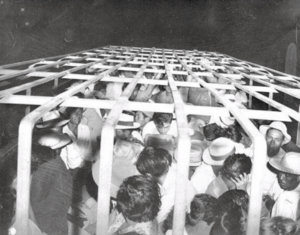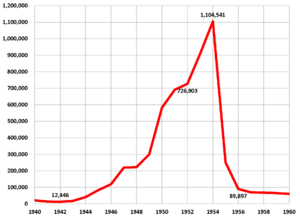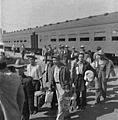Operation Wetback facts for kids
Operation Wetback was a special program by the United States government in 1954. It was created by Joseph Swing, who led the U.S. Immigration and Naturalization Service (INS). The program worked with the Mexican government. Its main goal was to send Mexican immigrants, especially those without legal papers, back to Mexico.
This operation used methods similar to military actions. It aimed to remove Mexican people from the United States. Some of these people were even American citizens. Millions of Mexicans had come to the U.S. legally before this time. They came through special programs. But Operation Wetback was designed to send many of them back.
The program caused problems between Mexico and the United States. Even so, it started because the Mexican government asked for help. They wanted to stop people from entering the U.S. illegally. At that time, Mexican workers could come to the U.S. legally through the Bracero program. This program began during World War II. Operation Wetback was also a response to farmers and businesses. They were worried about Mexicans living in the U.S. without legal permission. When the program started, the U.S. Border Patrol made many arrests and deportations.
Contents
Why Operation Wetback Started
Mexican Workers Before World War II
In the early 1900s, Mexico started to discourage its citizens from moving to the United States. President Porfirio Díaz was one of the first to do this. Mexican officials knew that workers leaving for the U.S. were needed in Mexico. They wanted to build up Mexico's own economy and industries. Mexico did not have a lot of money. But it had many workers. These workers were important for modernizing the country.
Meanwhile, the farming industry in the United States grew a lot. This created a big need for workers. From the 1920s onward, Mexicans became the main source of labor for U.S. farms. This was especially true in the Southwest. Each year in the 1920s, about 62,000 workers came to the U.S. legally. More than 100,000 came illegally.
Mexican farm owners also wanted their workers to return from the U.S. They put pressure on the Mexican government. Many workers had crossed into the U.S. This caused crops to rot in Mexican fields. At the same time, American farms were also growing. They kept hiring Mexican workers, even those without papers.
The Bracero Program (1942–1964)
During World War II, the Mexican and American governments made an agreement. It was called the Bracero program. This program allowed Mexican workers to come to the U.S. for short periods. They worked on farms. In return, the U.S. promised to have stronger border security. They also promised to send illegal Mexican immigrants back to Mexico.
Instead of sending soldiers, Mexico would send workers to the U.S. The U.S. needed cheap labor for its farms. Mexico hoped to use the workers who returned home to help its own industries grow. The program began on September 27, 1942. The first braceros came to the United States.
The program promised braceros good wages, housing, and food. They were also safe from military service. But sometimes, workers did not get what was promised. They were denied work for different reasons. They also often did not get the right paperwork. The Bracero Program changed a lot over its 22 years.
After this agreement, Mexico kept pushing the U.S. to make its border more secure. Otherwise, Mexico threatened to stop the legal flow of workers. In 1948, immigration officials opened the Texas-Mexico border. Thousands of workers without papers crossed. Border Patrol agents even took many of them straight to cotton fields. This event was called the El Paso incident. It showed how the U.S. government was involved in moving these workers. This also went against earlier agreements with Mexico. Two million Mexican people took part in the program. But it did not stop illegal immigration. This eventually led to Operation Wetback in 1954.
Illegal Migration After 1942
Even with the Bracero program, American farmers kept hiring workers without papers. They needed more labor. The Bracero program could not handle how many Mexicans wanted to work in the U.S. Many who could not become braceros crossed illegally. They hoped to find better wages and opportunities. About 70% of people trying to come to America were turned away. This was because they were seen as not suitable for various reasons.
Mexico often had food shortages. Most of the food grown there was sent to other countries. Hunger and poor government, along with a growing population, made many Mexicans try to enter the U.S. They wanted jobs and a better life. Mexico's population nearly tripled in 40 years. The Mexican government also made it harder to find jobs in farming. This gave Mexicans another reason to seek higher-paying jobs in the U.S.
People in the U.S. worried about immigrants who did not fit in. There were also concerns about border crossings. This led the INS to increase its raids and arrests in the early 1950s. This happened before Operation Wetback. The Korean War and the Red Scare also made border security tighter. This was to prevent communist spies from entering.
Large deportations also affected farming in California and Arizona. The U.S. had promised farmers more Bracero workers. During the Bracero program, about 4.6 million workers came to America legally. Other immigrants who were turned away still entered. This was because of job opportunities in the Southwest. California became very dependent on these workers. Texas kept hiring workers illegally, even after it was banned. But because of the need for farm labor, this was often ignored. Both countries benefited from the program. But the large number of immigrants caused President Eisenhower to end the program with Mexico.
Border Control Before Operation Wetback
In 1943, more U.S. Border Patrol Officers were placed along Mexico's northern border. Mexican landowners and farmers were unhappy with the Bracero program. They put pressure on the Mexican government. This led to a meeting in Mexico City. Four U.S. government agencies were there: the Department of Justice, the Department of State, the INS, and the Border Patrol. This meeting resulted in more border patrol by the U.S. But illegal immigration continued.
One big problem was that more pressure from Mexico led to more deportations. But the deported Mexicans quickly reentered the U.S. To stop this, the Mexican and American governments made a plan in 1945. They would deport Mexicans deeper into Mexico. They used planes, boats, and trains. However, in 1954, talks about the Bracero program broke down. This led the Mexican government to send 5,000 troops to its border with the U.S.
Harlon Carter, who led the Border Patrol, planned something called Operation Cloud Burst. He wanted President Dwight Eisenhower to use the military. This would help round up illegal entrants at the border. It would also raid migrant camps and businesses inside the U.S. But Eisenhower did not allow the use of federal troops. This was because of a law called the Posse Comitatus Act. Instead, he chose Army General Joseph May Swing to lead the Immigration and Naturalization Service. Eisenhower gave Swing the power to fix border control issues. This was to help with labor talks with Mexico.
Operation Wetback (1954)
How It Worked
At its busiest, the Bracero program gave about 309,000 contracts to Mexican workers. After this, many people were sent back to Mexico. This was part of Operation Wetback. Similar deportations happened during the Great Depression. Operation Wetback was a program of huge sweeps. It targeted Mexicans, both immigrants and sometimes Mexican-American citizens born in the U.S. The U.S. Border Patrol and the Mexican government worked together. Planning began in early 1954. The program was officially announced in May 1954. Harlon Carter was a key leader of Operation Wetback.
In June, special teams of 12 Border Patrol agents began their work. They used buses, planes, and temporary processing stations. Their job was to find, process, and deport Mexicans who had entered the U.S. illegally. A total of 750 immigration and border patrol officers were used. They also had 300 jeeps, cars, and buses, plus seven airplanes. The teams focused on quick processing. Planes helped coordinate with ground efforts. People were quickly sent into Mexico. Those deported were given to Mexican officials. These officials then moved them to central Mexico, where there were many job openings. About 25% of these Mexicans were deported on crowded boats. These boats were compared to slave ships. The operation included cities like Los Angeles, San Francisco, and Chicago. But its main focus was on border areas in Texas and California.
In the first year of Operation Wetback, over 1 million "returns" happened. A "return" means someone who was not allowed to be in the U.S. was moved out. This included many workers without papers who fled to Mexico. They feared arrest. Over half a million people left Texas alone. The total number of sweeps dropped to about 242,608 in 1955. It kept going down each year until 1962. Then, there was a small increase in arrested workers. Even with fewer sweeps, the number of Border Patrol agents more than doubled to 1,692 by 1962. An extra plane was also added.
During the entire operation, American farmers kept hiring illegal workers. This was because illegal labor was cheap. Farmers also wanted to avoid the rules of the Bracero program. Illegal immigration continued despite Operation Wetback's efforts. Also, many U.S. citizens were wrongly removed. These reasons largely caused the program to fail. Because of these issues, Operation Wetback lost its funding.
The program did lead to a more lasting border control presence along the Mexico–United States border.
Timeline of Operation Wetback
| Date | Event |
|---|---|
| June 9 | California roundups and deportations begin. |
| June 10 | Phase One Arizona-California, Operation: Buslift
First bus leaves El Centro, California, for Nogales, Arizona. It carries people arrested in San Francisco and at roadblocks. 28 buses take 1,008 migrants to Arizona. From there, they are sent deeper into Mexico. |
| June 17 | Phase Two of California to Arizona, Operation: Sweeps
Farming areas in Arizona and Southern California become the main targets for sweeps. INS officials get help from farmers to find workers without papers. |
| June 17–26 | With help from local police, 4,403 people are rounded up. 64% of them worked in non-farm jobs. |
| June 20 | Sweeps continue across California's Central Valley. Bases are set up in Fresno and Sacramento. |
| June 24 | Bills 3660 and 3661 are suggested in Congress. They aim to stop employers and smugglers from hiring or bringing in illegal immigrants. Neither bill passed. |
| July 3 | The first mobile task force is sent to McAllen, Texas. Their goal is to set up roadblocks, inspect trains, and discourage migrants from heading north. |
| July 15 | The operation fully begins in Texas. It focuses on the Lower Rio Grande Valley. |
| September 3 | First deportation by sea. The SS Emancipation and SS Vera Cruz make 26 trips. They sail 2,000 miles from Port Isabel, Texas, to Veracruz, Mexico. Each ship carries about 800 illegal immigrants. |
| September 18 | First airlift from the Midwest begins. People deported from Chicago are flown to Brownsville, Texas. More airlifts arrive from Kansas City, Saint Louis, Memphis, and Dallas. From Brownsville, these people are sent to Veracruz by sea. |
What Happened After
The name "wetback" is a very offensive word. It was used for people who supposedly swam across the Rio Grande river to enter the U.S. It became a hurtful term for Mexican workers in general. This included people who were legal residents or American citizens. Some of their families had lived in the U.S. long before the Southwest became American territory.
One major problem for those deported was being sent to unknown parts of Mexico. They struggled to find their way home. They also found it hard to support their families. More than 25% of arrested Mexicans were sent to Veracruz on cargo ships. Others were taken by land to southern Mexican cities. Those arrested were often deported without getting their belongings in the U.S. They also could not contact their families right away.
Deported Mexicans were often left without food or jobs when they were released in Mexico. They sometimes faced very difficult conditions. In July 1955, 88 deported workers died in 112-degree heat. Another issue was that many people who had been deported tried to cross the border illegally again. From 1960 to 1961, these "repeaters" made up 20% of all deportees. Some U.S. Border Patrol agents even shaved heads to mark people who kept trying to reenter the U.S. There were also reports of harsh treatment for those who repeatedly crossed illegally. While most complaints were not officially recorded, there were over 11,000 formal complaints from legal bracero workers between 1954 and 1964.
Operation Wetback was the peak of stronger immigration enforcement. The number of people sent back or removed from the U.S. grew quickly. It went from 12,000 in 1942 to 727,000 in 1952. It kept rising under President Eisenhower. It reached its highest point of 1.1 million in 1954, the year of Operation Wetback. Then, the number of enforcement actions dropped by more than 90% in 1955 and 1956. In 1957, it was 69,000, the lowest since 1944. The number of enforcement actions rose again in the 1960s and 1970s. But it did not go higher than the 1954 peak until 1986.
At the same time, the Bracero program was also growing. It offered more legal chances for Mexican workers. Even though it started during the war, the Bracero program grew most after the war. The number of wartime braceros peaked at 62,000 in 1944. But the number started to rise again in the late 1940s. It reached its highest point in 1956. That year, the program gave temporary work permits to 445,000 Mexican workers.
Images for kids
See also
 In Spanish: Operation Wetback para niños
In Spanish: Operation Wetback para niños




